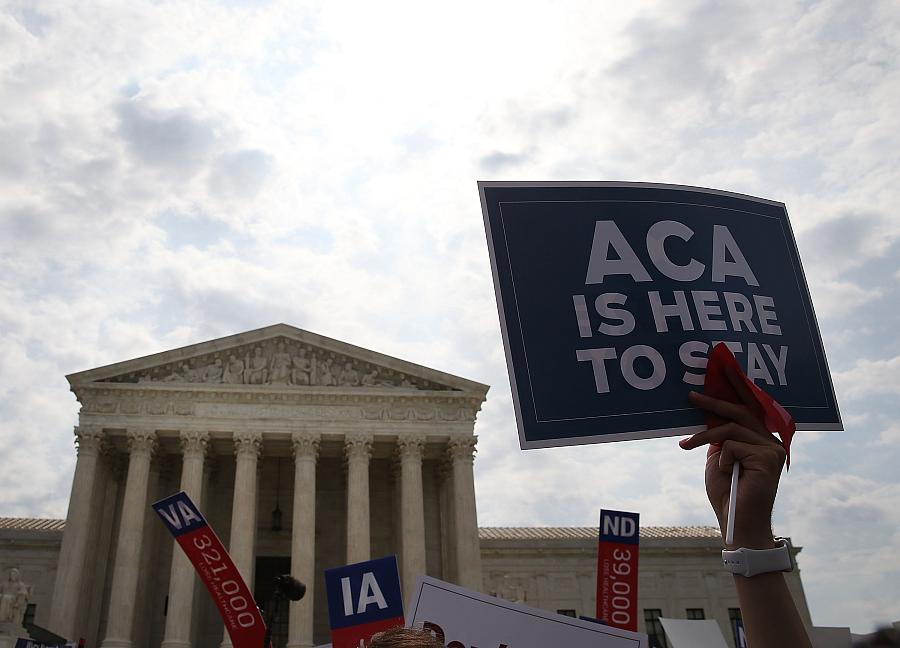Health policy expert: ‘I’m here to tell you the ACA is still working’

Or is it?
(Photo: Mark Wilson/Getty Images)
The Affordable Care Act was spared the guillotine when the Democrats won the House last fall. No Republican repeal bill is getting past a Democratic House.
But that doesn’t mean Obamacare’s opponents don’t still have knives out for the law, and death by a thousand cuts is still mortal, right?
“For supporters of the ACA, we dodged a bullet,” Prof. Gerald Kominski, former director and now senior fellow at the UCLA Center for Health Policy Research, told 2019 California Fellows this week. “However, just because the Dems won the House does not mean the ACA is safe at all.”
Many of the quieter threats to the landmark 2010 law fall under the banner of “administrative changes.” For instance, critics say the Trump Administration’s approval of waivers allowing work requirements for Medicaid programs in eight states leads to eligible people losing insurance — more than 18,000 Arkansas residents already lost coverage in 2018 after that state imposed work rules.
“There’s a tremendous amount of latitude in the rule-making process at the federal level,” Kominski said, adding that Trump has repeatedly used such powers to “sabotage” the ACA.
The Trump Administration has also ushered in new rules that encourage the spread of health plans that don’t hew to the ACA’s coverage requirements, such as association plans and short-term policies, both of which can siphon healthier enrollees from the Obamacare exchange markets and raise premiums, while leaving enrollees of these skimpier plans vulnerable to financial risk.
Those fears haven’t come to pass so far. “There’s no evidence to date that these association health plans are growing at any remarkable rate,” Kominski said.
But such administrative threats pale in comparison to the Texas-led lawsuit challenging the constitutionality of key provisions of the ACA. After a Texas judge ruled the ACA invalid in December, the case is now pending before the Fifth Circuit Court of Appeals. Many expect it to wind up before the Supreme Court, setting up yet another perilous live-or-die moment for the ACA in the highest court of the land.
Meanwhile, Democrats in Congress are divided between those who want to incrementally reinforce the ACA, and those pushing for a more radical overhaul of the system through “Medicare for All” or some other version of a single-payer system.
While that simmering policy debate will provide ample fodder for the 2020 Democratic primary, states such as California are already pushing ahead with changes to reinforce the ACA.
California Gov. Gavin Newsom has proposed replacing the ACA federal mandate to buy insurance with a state mandate. He also wants to expand Medicaid to undocumented residents up to age 26 and extend Obamacare exchange subsidies for those making up to 600 percent of the federal poverty level. Another proposal would give the state’s Medicaid program authority to buy prescription drugs on behalf of enrollees.
The goal of expanding subsidies is to offer relief to middle-class families whose incomes are too high to qualify for subsidies under the current rules, which only extend up to 400 percent of the federal poverty level, or $100,400 for a family of four. “Families with a decent income are still struggling to pay for health insurance,” Kominski said. “I could make an argument that you could go higher than 600 (percent).”
January polling from the Kaiser Family Foundation has found that among Democrats, 51 percent would prefer that Democrats in the House focus on strengthening the ACA, versus 38 percent who say they should push for a national Medicare for All plan. So why aren’t House Democrats churning out fix-the-ACA bills?
“We’re not seeing these legislative proposals because they’re not going anywhere,” Kominski said, pointing to President Trump and the Republican-led Senate. If the Senate and White House were to turn blue in 2020, that could change fast. Building on the ACA would be a far easier political lift than overturning the entire system and abolishing private insurance, as Medicare for All proposals call for.
“That’s the pragmatic approach,” Kominski said.

